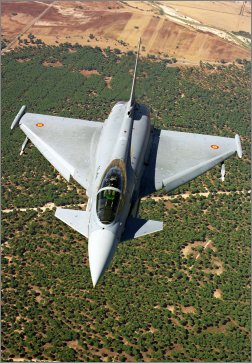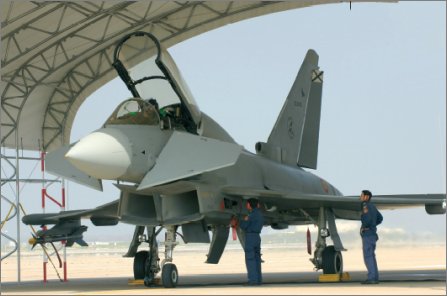The Spanish air force is broadly satisfied with the performance of its first 13 Eurofighter Typhoon interceptors after amassing almost 1,100 flight hours, and is on track to declare the type ready to support NATO operations from 2009, the service says.
|
Spain's future Typhhon fleet will equip five squadrons by late next decade |
“We are quite happy with what we are doing. We are on the expected path,” says Col Javier Salto, 11 Wing and Moron AB commander.
Going operational
The air force is close to a decision to stand up its first operational squadron later this year, Salto adds. “Probably around mid-year we will split half of the 113 Sqn pilots to form 111 Sqn and retain five or six instructor pilots on 113.”
Each of Spain’s four frontline Eurofighter squadrons will have a complement of 18 aircraft and 21 pilots, while the OCU’s final strength will total 14 aircraft and 14 pilots. Additional units to receive the aircraft will be 112 Sqn – also to be located at Moron – and 141 and 142 squadrons at Albacete AB. The service’s first operational squadron is required to participate in a NATO Tactical Leadership Programme exercise in 2008, by which time 80% of its pilots should be combat ready. Frontline duties will follow from 2009, with the aircraft to initially be used for air-to-air missions only. An air-to-surface strike capability will follow with the delivery of Block 8+ Tranche 2 aircraft from 2010, says Gen Jesus Pinillos, the air force’s head of the Eurofighter programme.
Spain is the junior partner on the four-nation Eurofighter programme, with its eventual total of 87 aircraft comparing with the 180 to be delivered to Germany, 121 to Italy and 232 to the UK. However, unlike its European partners, Spain is not currently replacing any aircraft type with the Typhoon, and instead plans to gradually draw down its remaining fleet of 50 Dassault Mirage F1s by 2012 while maintaining a core fleet of upgraded Boeing F-18 strike aircraft until 2030. However, Spain’s current total of 250 fast jets – including CASA C-101s and upgraded Northrop F-5M trainers – will be reduced over time, says Pinillos.
Service officials describe 113 Sqn’s current pace of operations as slow – the OCU’s 700 flying hours amassed last year were around 100h lower than planned – but say it is succeeding in training pilots and writing tactical training manuals. The unit is also currently completing a training syllabus for Moron’s Typhoon full mission simulator and cockpit, desktop and crew trainers, and is developing advanced air-to-air combat tactics. An operational evaluation is scheduled for September to validate this training system, say squadron officials.
Basic training
The OCU currently provides basic Phase I training covering take-off and landing, formation flying and instrument flight rules instruction and, during Phase II, basic weapon system use and multi-ship intercepts. More missions are flown using simulators than aircraft during these phases. Phase III and IV instruction is scheduled to begin from June, with these to cover basic and advanced operational training respectively and to prepare pilots to be section/flight leaders or package commanders.
Madrid’s Typhoon pilots have amassed considerable previous experience on the F-18, with the exception of two former Mirage F1 pilots, but 113 Sqn now believes that it is ready to bring less experienced pilots onto the type, says flying group commander Lt Col Jose Juanas. Drawing parallels with Spain’s past experience in fielding the F-18, he notes: “We have learned that we can use a new pilot, but we must have enough hours on the operational squadron to maintain his skills.”
The air force will begin training with the Typhoon’s defensive aids subsystem next month, while 113 Sqn also plans to by year-end conduct test firings of the aircraft’s cannon and AIM-9 Sidewinder and Raytheon AIM-120 AMRAAM air-to-air missiles. BGT’s IRIS-T short-range air-to-air missile, meanwhile, is scheduled to enter service with the type next year. The service expects to begin staffing 112 Sqn during 2009 after completing pilot training for 111 Sqn, with crews for Albacete’s 141 and 142 squadrons expected to begin their instruction in 2011-12 and 2015, respectively.
|
113 Sqn's Typhoons fly an average of 10h each month |
Spain’s air force began operating its first production Eurofighter at EADS Casa’s Getafe site near Madrid in September 2003 under a partnering approach similar to the UK Royal Air Force’s initial Case White arrangement with BAE Systems, but since May 2004 has relied on “organic” support to conduct operations at Moron. The base now has engineering, maintenance, quality control and supply units for the Eurofighter, a test cell for its Eurojet EJ200 engines and will receive additional support equipment this year. Juanas says the provision of air force support has proved more difficult than expected, forcing the service to sign a transitional deal with EADS to provide off-aircraft support until late this decade.
Challenges in supporting the Typhoon stem from its “operational immaturity” and from the need to conduct retrofit work to several aircraft at any one time – currently three of 113 Sqn’s 13 aircraft are being upgraded – resulting in several different equipment standards across the small fleet, says Juanas. The operational aircraft have also previously encountered some problems not discovered by the Eurofighter programme’s development aircraft fleet, forcing delays and limiting availability, he says. Juanas adds, however: “We are fairly sure that most of the problems have now been identified and will be rectified – particularly with Tranche 2.” Spain’s 111 Sqn will receive its first Tranche 2 aircraft in late 2007.
Juanas says the Typhoon’s most important performance characteristics are its high thrust-to-weight ratio and impressive turn performance at both supersonic and subsonic speeds. He adds that the aircraft’s helmet-mounted display and direct voice input features are also important factors when compared with legacy aircraft such as the F/A-18. “They are a very simple way to obtain and evaluate all the information the aircraft can provide,” he says.
More capability
The Typhoon’s Euroradar-supplied Captor radar also offers a 50% increase in capability over the F-18’s Raytheon APG-67, says Juanas, while cautioning: “The radar information displayed is extremely good, but you need good training to be able to understand it. The software of the radar needs to be improved, but the functionality is good.”
Moron’s current complement of 1,200 personnel will increase to around 1,500 within the next couple of years as Eurofighter activities ramp up. The base is also home to the air force’s 221 Sqn, which operates seven Lockheed Martin P-3A/B Orion maritime patrol aircraft and is close to concluding an operational evaluation of its first of five aircraft to be upgraded to the P-3M standard by EADS Casa. The US Air Force has maintained a continuous presence at Moron AB since 1953 and currently positions assets such as Lockheed C-5 Galaxy transports and Boeing KC-135 and McDonnell Douglas KC-10 tanker/transports at the site, supported by around 700 personnel.
CRAIG HOYLE / MORON AIR BASE
Source: Flight International

























